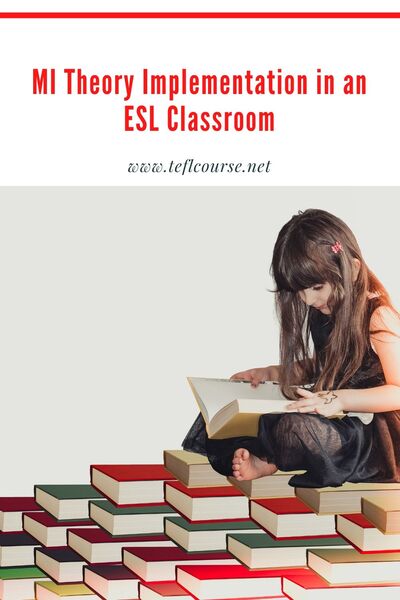MI Theory Implementation in an ESL Classroom

There are many types of multiple intelligences such as (Visual intelligence-Musical intelligence – Kinesthetic intelligence – Verbal intelligence – interpersonal & intrapersonal intelligences … etc.) we must take care of our students' types and design our lesson according to their intelligences. The verbal intelligence involves knowing which comes through language. Mathematical intelligence uses numbers, math, and logic to understand any topic. Visual intelligence represents knowing through shapes, patterns, and pictures. Intrapersonal intelligence is showing people who prefer to work individually. Also, kinesthetic intelligence is based on physical movements. Interpersonal intelligence is learning through personal interaction and work in groups. Naturalist Intelligence involves all the information which relates to the natural world and its phenomena. Moreover, musical intelligence is the knowledge that happens through sound and vibration. (Gangi S., 2011)
Table of Contents
What are multiple intelligences?
During my Numeracy sessions, I use a lot of techniques which I want to keep such as:
One-minute reflection periods:
Do you want to teach English abroad? Take a TEFL course today!
This post was written by our TEFL certification graduate Radwa G. Please note that this blog post might not necessarily represent the beliefs or opinions of ITTT.
What are multiple intelligences?
Multiple intelligences are very beneficial. It helps us to know our students well and to consider their different proclivities when we prepare our lessons. MI presents to us the different types of students which we may find in our classes. Knowing the different types of multiple intelligences will help the teachers to choose their teaching strategy which helps them to reach all their students' interests. MI also helps the teachers to prepare an interesting session for the largest number of students in the classroom through preparing (sheets, PowerPoint presentations, activities, videos or songs, online games…etc.) which suit their concerns. Of course, we can't reach all the students' intelligences but we can do our best to reach most of it.
Also Read: Why I Prefer Teaching ESL to Individuals Rather than Groups
Personal experience
I have 25 students in my class. My students are mostly of musical, linguistic, kinesthetic, spatial, interpersonal, and intrapersonal intelligent types, so when I choose my strategies inside the class I consider all these differences to make sure that all the students are engaged in the lesson by grabbing their attention and reaching their interest. MI theory opens the door to many teaching strategies that can be implemented in the class such as storytelling, Graphic Symbols, Classroom Theater, Body Maps.. etc. ( Armstrong T.,2009). There are new teaching strategies that I want to add to my sessions, others which I want to keep, and some of them which I want to change.

During my Numeracy sessions, I use a lot of techniques which I want to keep such as:
Storytelling:
I always use small stories to explain a specific part of my lessons. Through this technique I grantee reaching the linguistic students' interest.
For example:
During explaining the vocabulary for (Analog clock) lesson to the students, I tell them a story of a clock that has two sons the taller one called Minute hand and the shorter one called Hour hand. The minute hand is a very polite boy who stays always on number 12, but the hour hand is very active. He always moves through all the numbers. I will keep using this technique because it achieves a huge success with the students, especially at this age. Stories are grabbing their attention and reaching their interest.
Also Read: Child Development – Piaget's Theory Summarized
Brainstorming:
This is an amazing technique that we can use with all the stages. Through brainstorming, students can share anything that comes to their minds and I keep asking more questions, which leads students to become very excited to hear the explanation and know the answers to their questions.
For example:
To introduce (Compare Lengths) lesson. I start the session with this question (How do you know that the piece of paper is longer than the pencil?) students begin to answer different answers and I start my explanation through their answers. I will not leave this technique because it helps the students' brains to develop and increase creativity among the students. This technique targets linguistic students.
Graphic symbols:
This technique is targeting spatial students. Through it, I can use drawing as a tool to describe the concepts. It's a very important way because it helps the student to understand and re-calling the new information.
Also Read: How long does it take to get a TEFL job?
For example:
Draw a clown on the whiteboard using geometric shapes and write the name of each shape on it.
I will keep using this strategy because it's very beneficial for the kids as it helps them in recognizing and remembering the shapes and their names easily.
Board games:
it's an effective tool to assist the students and know if they understand the lesson well or not. I always use it after finishing the whole week's lessons to be sure that the students get all the information before starting a new week. This strategy targets interpersonal and kinesthetic students. I use this strategy because it's very useful and it's an important tool that makes me sure that the students got the concepts well.
One-minute reflection periods:
this strategy I keep using inside my classes to reach the intrapersonal interest because this type of student likes to work alone.
On the other hand, there are strategies that I can use it also inside my class and change some of it such as, Journal writing (It's a very smart technique to target the linguistic students because we encourage them to write their thoughts and we can use it by letting them write about the lesson subject, as a Math teacher I can let my students write an article about how we can use mathematics in our life and collect all the articles in math magazine), color cues (I recognize that using colors is very useful for the students because they can save and recall the information by remembering the concepts colors. I can use different colors of markers or let the students use different colors of pens while writing in the sheets or copybooks).There is a point that I want to change which is using music during the sessions. I use the music only through video or song to introduce the lesson for the students or to stress the important parts in the lesson.For example, I use a part of this song to introduce the shapes for my students.
Also, I realize that I can use the music in other different ways such as using some vocabulary in a rap song, playing certain music during explaining the lesson to connect the concept with the music and this makes the re-calling for the information easier.
Do you want to teach English abroad? Take a TEFL course today!
In the end, I believe that multiple intelligences are very important especially during planning lessons. If we understand our students well we will have the ability to design lesson plans which suit their abilities and grantee reaching their interest. Multiple intelligences add huge value to education because it transforms education from a boring process to an interesting one. When students find that the sessions become more interesting and they have fun during it they will be more engaged in the lessons and that will help them to be lifelong learners because they enjoy every single moment and the information stays a long time with them.
In conclusion, using MI makes teachers' role easier and it will help them to deliver the information softly to the students and understand their needs.
Apply now & get certified to teach english abroad!
Speak with an ITTT advisor today to put together your personal plan for teaching English abroad!
Send us an email or call us toll-free at 1-800-490-0531 to speak with an ITTT advisor today.
Related Articles:
- Top TEFL Countries That Hire Teachers in Advance
- Top 8 Resources For Researching Teaching English Abroad
- The 10 Best Destinations for Teaching English Abroad in 2018
- Why You Should Take Specialized TEFL Courses
- Where to Earn the Highest Salaries Teaching English Abroad
- The Top Hiring Seasons for Teaching English Abroad




